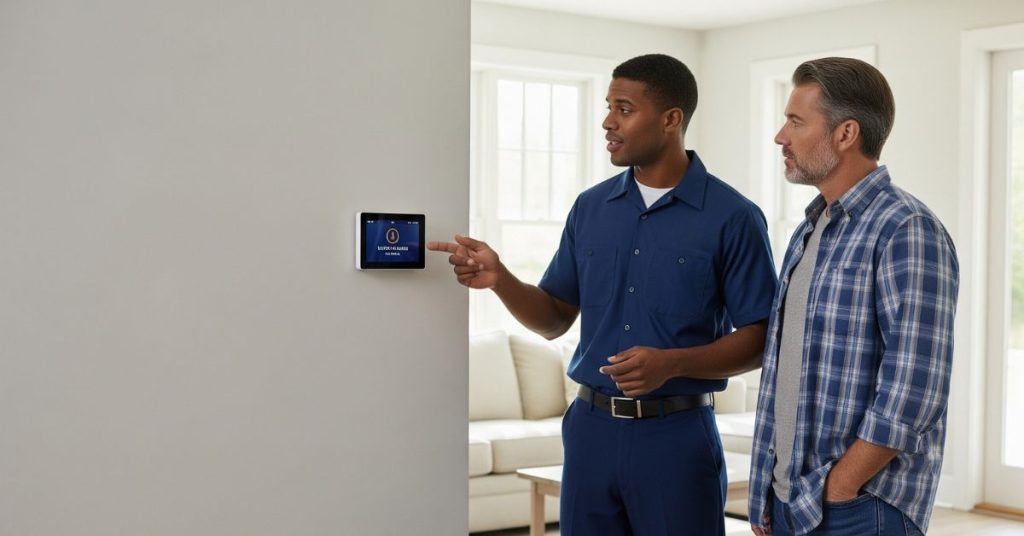Table of Contents
Maintaining your thermostat is an essential step toward ensuring your home’s comfort, optimizing energy efficiency, and reducing environmental impact. By practicing eco-friendly thermostat maintenance, homeowners can extend the lifespan of their devices while keeping energy bills under control. This guide will walk you through DIY thermostat maintenance for beginners with step-by-step, sustainable methods.
Understanding the Role of Your Thermostat
Your thermostat is the control hub for your heating and cooling systems, signaling them to maintain the desired indoor temperature. A poorly maintained thermostat can cause:
- Uneven heating or cooling
- Higher energy consumption
- Inconsistent indoor comfort
Learning how to maintain a thermostat ensures accurate temperature control and supports sustainable home living.
Benefits of Eco-Friendly Thermostat Maintenance
1. Energy Efficiency – A clean and calibrated thermostat ensures accurate temperature control, preventing HVAC overwork and saving energy through proper thermostat care.
2. Extended Lifespan – Regular maintenance minimizes wear, reduces strain on system components, and helps your thermostat and HVAC unit last longer.
3. Cost Savings – Optimized thermostat performance improves efficiency, lowering energy usage and monthly bills while supporting smart, cost-effective home maintenance practices.
4. Environmental Protection – Reduced energy consumption from efficient thermostat operation lowers greenhouse gas emissions, helping protect the planet for future generations.
Safety Precautions Before You Start
Before starting your DIY thermostat maintenance, always:
- Turn off power at the breaker panel.
- Wear insulated gloves when handling wiring.
- Use eco-friendly cleaning agents and reusable tools.
Step-by-Step Eco-Friendly Thermostat Maintenance
1. Inspect for Dust and Debris
Dust can cause inaccurate readings and waste energy.
How to clean a thermostat without damaging it:
- Remove the cover gently.
- Wipe with a reusable microfiber cloth.
- Use a hand-powered air blower instead of compressed air cans.
2. Check and Replace Batteries
Most programmable thermostats use batteries for backup power.
Eco-friendly tip:
- Use rechargeable batteries to cut waste.
- Replace yearly or when your display dims.
3. Clean the Sensors
A dirty sensor leads to incorrect readings.
Steps:
- Locate the small coil or thermistor inside.
- Clean with a dry cloth—avoid chemicals.
- Keep this in your thermostat care checklist.
4. Calibrate Your Thermostat
Accurate calibration saves energy.
How to improve thermostat accuracy:
- Compare it with a separate thermometer.
- Adjust according to your model’s manual.
- Calibrate yearly before seasonal changes.
5. Tighten Electrical Connections
Loose wires cause system issues.
Instructions:
- Turn off power.
- Use a manual screwdriver to secure wires.
- Avoid overtightening to prevent damage.
6. Update Smart Thermostat Software
For smart thermostat maintenance, updates are essential.
Benefits:
- Access to energy-saving algorithms.
- Improved HVAC optimization.
7. Optimize Thermostat Placement
Placement affects accuracy.
Best thermostat placement for accuracy:
- Keep away from direct sunlight.
- Avoid drafts or heat sources.
Seasonal Eco-Friendly Thermostat Settings
Spring/Summer:
- Set to 78°F (25°C) when at home.
- Use ceiling fans to reduce AC load.
Fall/Winter:
- Set to 68°F (20°C) during the day.
- Lower it when away or at night for more savings.
The U.S. Department of Energy recommends these thermostat settings to maximize comfort while reducing energy use.
When to Call a Professional for Thermostat Repair
Even with DIY thermostat troubleshooting, call an expert if:
- Your HVAC system short cycles frequently.
- The thermostat doesn’t respond to changes.
- Readings are always inaccurate.
- You see corroded or burnt wires.
- The thermostat screen is blank or unresponsive despite fresh batteries.
- There’s a burning smell or unusual noise coming from the unit.

Professional Help for Lasting Thermostat Efficiency
While DIY steps go a long way, some situations require expert attention to keep your thermostat performing at its best. Contact HVAC Alliance Expert for:
- Accurate thermostat calibration and repairs
- Professional installation of eco-friendly models
- Comprehensive HVAC system checks to boost efficiency
They can also ensure your thermostat is ideally placed—away from direct sunlight, drafts, and heat sources—to guarantee accurate readings and maximum energy savings.
Choosing an Eco-Friendly Thermostat
If it’s time for a replacement:
- Choose ENERGY STAR® certified models.
- Pick programmable or smart thermostats for automated savings.
- Look for models compatible with renewable energy.
Recycling Old Thermostats Responsibly
Many older thermostats contain mercury.
Eco-friendly disposal tips:
- Never throw them in the trash.
- Use certified thermostat recycling programs.
- Drop off at participating hardware stores.
Extra Tips for Long-Term Energy Savings
- Schedule regular HVAC tune-ups.
- Seal air leaks around your home.
- Improve insulation to maintain temperature.
- Keep thermostat maintenance tips as part of your seasonal home checklist.
Conclusion
Practicing eco-friendly thermostat maintenance for beginners not only improves your home’s comfort but also reduces energy bills and helps protect the environment. By following these DIY thermostat care tips, you can extend your thermostat’s lifespan, improve HVAC efficiency, and ensure consistent indoor temperatures year-round. Small, sustainable actions make a big difference in energy conservation.
However, some issues require expert attention to prevent costly damage. When your thermostat shows persistent problems, calling professional thermostat repair services ensures safe, precise, and long-lasting performance, keeping your home efficient and eco-friendly.
FAQs
To maintain your thermostat, clean dust from the interior, check wiring, replace or recharge batteries, calibrate temperature readings, and ensure proper placement away from heat or drafts.
Eco-friendly maintenance improves energy efficiency, reduces carbon footprint, lowers utility bills, and extends your thermostat’s lifespan while minimizing environmental impact.
For accurate temperature control, calibrate your thermostat at least once a year, preferably before peak heating or cooling seasons.
Absolutely. Many older thermostats contain mercury and must be recycled safely—not discarded in the trash. For more information, refer to the EPA’s mercury-containing consumer products guidelines.
In summer, set your thermostat to 78°F (25°C) when home. In winter, set it to 68°F (20°C) during the day and lower it at night or when away.


